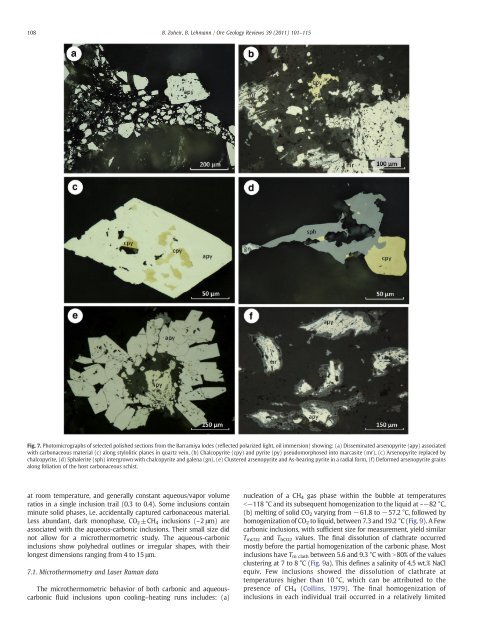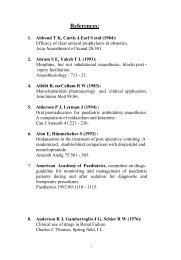Basem Ahmed Zoheir_Barramiya, OGR_2011.pdf
Basem Ahmed Zoheir_Barramiya, OGR_2011.pdf
Basem Ahmed Zoheir_Barramiya, OGR_2011.pdf
You also want an ePaper? Increase the reach of your titles
YUMPU automatically turns print PDFs into web optimized ePapers that Google loves.
108 B. <strong>Zoheir</strong>, B. Lehmann / Ore Geology Reviews 39 (2011) 101–115<br />
Fig. 7. Photomicrographs of selected polished sections from the <strong>Barramiya</strong> lodes (reflected polarized light, oil immersion) showing: (a) Disseminated arsenopyrite (apy) associated<br />
with carbonaceous material (c) along stylolitic planes in quartz vein, (b) Chalcopyrite (cpy) and pyrite (py) pseudomorphosed into marcasite (mr), (c) Arsenopyrite replaced by<br />
chalcopyrite, (d) Sphalerite (sph) intergrown with chalcopyrite and galena (gn), (e) Clustered arsenopyrite and As-bearing pyrite in a radial form, (f) Deformed arsenopyrite grains<br />
along foliation of the host carbonaceous schist.<br />
at room temperature, and generally constant aqueous/vapor volume<br />
ratios in a single inclusion trail (0.3 to 0.4). Some inclusions contain<br />
minute solid phases, i.e. accidentally captured carbonaceous material.<br />
Less abundant, dark monophase, CO2±CH4 inclusions (~2 μm) are<br />
associated with the aqueous-carbonic inclusions. Their small size did<br />
not allow for a microthermometric study. The aqueous-carbonic<br />
inclusions show polyhedral outlines or irregular shapes, with their<br />
longest dimensions ranging from 4 to 15 μm.<br />
7.1. Microthermometry and Laser Raman data<br />
The microthermometric behavior of both carbonic and aqueouscarbonic<br />
fluid inclusions upon cooling–heating runs includes: (a)<br />
nucleation of a CH 4 gas phase within the bubble at temperatures<br />
b−118 °C and its subsequent homogenization to the liquid at ~−82 °C,<br />
(b) melting of solid CO 2 varying from −61.8 to −57.2 °C, followed by<br />
homogenization of CO2 to liquid, between 7.3 and 19.2 °C (Fig. 9). A Few<br />
carbonic inclusions, with sufficient size for measurement, yield similar<br />
TmCO2 and ThCO2 values. The final dissolution of clathrate occurred<br />
mostly before the partial homogenization of the carbonic phase. Most<br />
inclusions have Tm clathbetween 5.6 and 9.3 °C with N80% of the values<br />
clustering at 7 to 8 °C (Fig. 9a). This defines a salinity of 4.5 wt.% NaCl<br />
equiv. Few inclusions showed the dissolution of clathrate at<br />
temperatures higher than 10 °C, which can be attributed to the<br />
presence of CH 4 (Collins, 1979). The final homogenization of<br />
inclusions in each individual trail occurred in a relatively limited

















